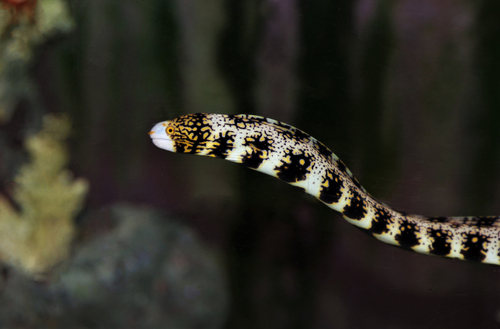Also known as the snowflake moray, starry eel, and the white and zebra moray eel, this carnivorous eel is named for the decorative white pattern on its otherwise brown and yellow body.
Growing up to 2 feet in length in captivity, the snowflake eel is one of the best eels for a saltwater aquarium due to its ease of care. Because it is an aggressive species, careful consideration should be given to tank mates, as any species that share a tank with the snowflake eel should also be larger, aggressive fish species.
The 15 best snowflake eel tank mates are as follows:
- Lionfish
- Yellow Tang
- Marine Betta
- Picasso Triggerfish
- Yellow Longnose Butterfly Fish
- Emperor Angelfish
- Foxface Rabbitfish
- Brittle Sea Star
- Porcupine Pufferfish
- Panther Grouper
- Reef Triggerfish
- Sand Sifting Starfish
- Blue Tuxedo Urchin
- Serpent Sea Star
- Leopard Wrasse
Read on to learn more about the snowflake eel and its tank mates.
Contents
Snowflake Eel Tank Mates – What you Need to Know
With any large, carnivorous species like the snowflake eel, tank mates need to be of a similar size and disposition. Snowflake eels don’t prey on fish, as their diet largely consists of shellfish such as clams, shrimp, and mollusks. However, eels have poor eyesight, relying primarily on their other senses to hunt, meaning they may inadvertently munch on smaller fish.
Here, we’ll break down the four most important things to consider in a snowflake eel tank mate.
Temperament
Any tank mate for a snowflake eel should match its aggression. Aggressive species are territorial but will keep to themselves when surrounded by those of a similar temperament.
While snowflake eels are classified as an aggressive species, this temperament is really only displayed at feeding times, when their natural competitive nature takes over. At other times, the snowflake eel is quite easygoing and more docile than other saltwater morays. This makes them the most popular eel for a saltwater aquarium.
Size
Since eels have notoriously bad eyesight, any fish that can fit into their mouth will potentially become a meal for it. This means that you should avoid tank mates smaller than 4 – 5 inches.
Competition
Because snowflake eels get particularly aggressive during feeding time, so you’ll need to ensure you have enough food to go around. Tank mates with a diet consisting of mainly crustaceans may compete for food with the snowflake eel, so you’ll need to make sure there is enough food for all the species in your saltwater tank.
Snowflake eels are relatively docile and will keep to themselves in the tank without going out of their way to antagonize other species.
You shouldn’t place more than one snowflake eel in the same tank, as they tend to be aggressive with each other and with other eel and moray species.
Parameters ; Tank Setup
Snowflake eels need a minimum tank size of 75 gallons. If you plan on adding other tank mates, you’ll need even more space that suits the needs of your other saltwater aquarium species.
Eels are natural hiders, so you’ll need lots of rocks and plants in which your snowflake eel can hide. It’s common to see very little of your snowflake eel throughout the course of a day, as they like to hide in rock crevices with just their head showing.
Since eels are very strong, you’ll need to make sure your rock setup is strong enough to withstand being jolted and rocked by your eel. Segments of PVC pipes are a common decoration in many saltwater aquariums that house snowflake eels, as the pipes are tough and provide the hiding places towards which eels are naturally inclined.
Hiding is especially common if your snowflake eel is new to the tank, as it will likely feel frightened and not be comfortable enough to explore its surroundings. They become more active at night as nighttime is its natural hunting time.
While snowflake eels are technically reef safe, they can often damage corals by knocking them loose or create a lot of debris that degrades the long-term health of your coral. If you choose to keep your snowflake eel in a reef tank, make sure you have a strong filtration system to keep your reef tank healthy.
Keep in mind that the snowflake eel can squeeze itself into almost any opening, so keep filters and any plumbing systems tightly covered to keep your eel from escaping. The top of the tank should also be securely covered, as snowflake eels can jump out of the tank.
Water parameters for your snowflake eel should be as follows:
- Temperature: 72 – 78 degrees Fahrenheit
- pH: 8.1 – 8.4
- Salinity/gravity: 1.020 – 1.026
- dKH: 8 – 12
15 Best Snowflake Eel Tank Mates
Check out these other similar posts:
- Bristlenose Pleco Tank Mates
- Giant Danio Tank Mates
- Chinese Algae Eater Tank Mates
- Jaguar Cichlid Tank Mates
1. Lionfish
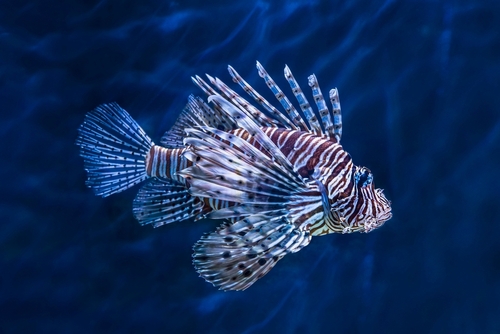
- Scientific Name: Pterois sp.
- Adult Size: 12 – 15 inches
- Compatible with: other large, aggressive saltwater aquarium fish and non-crustacean invertebrates
- Care Level: Easy to medium
- Origin: Indo-Pacific coral reefs
Colorful and active; easy to care for, Lionfish will get along well with other large saltwater aquarium fish. They will remain near the middle and top of the aquarium, away from the bottom-dwelling eels. Still, Lionfish need a minimum tank size of 125 gallons. They can be venomous and may compete with snowflake eel for food.
2. Yellow Tang

- Scientific Name: Zebrasoma flavescens
- Adult Size: 8 inches
- Compatible with: Large, aggressive or semi-aggressive aquarium fish of similar size.
- Care Level: Easy to medium
- Origin: Indo-Pacific coral reefs
Yellow Tang are herbivores, so they won’t compete with snowflake eels for food. They are attractive and brightly colored to brighten your tank. They are the perfect snowflake eel tank mates because they are active, social and don’t need a lot of space.
Cons: Will nip at corals and may cause long-term health effects to your coral reef.
3. Marine Betta (aka Comet Betta)

- Scientific Name: Calloplesiops altivelis
- Adult Size: 8 inches
- Compatible with: other large saltwater species, either peaceful, semi-aggressive, or aggressive
- Care Level: Easy
- Origin: Indo-Pacific Ocean
Comet Betta are attractive, easy to care for, peaceful and territorial, making them the perfect snowflake eel companions. However, they may compete with snowflake eels for hiding places.
4. Picasso Triggerfish (aka Lagoon Triggerfish)
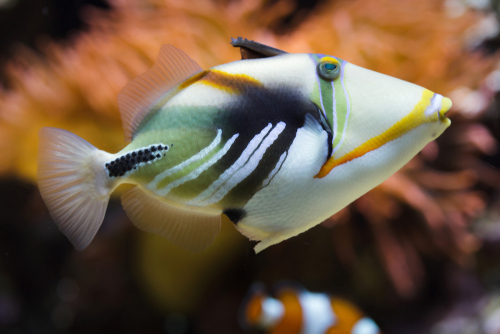
- Scientific Name: Rhinecanthus aculeatus
- Adult Size: 10 inches
- Compatible with: Large, aggressive saltwater species
- Care Level: Easy to medium
- Origin: Indian and Pacific Oceans
Colorful and easy to care for, Picasso triggerfish don’t require as much space as some saltwater species. Nonetheless, they are temperamental, and can knock over rocks and other aquarium decor.
5. Yellow Longnose Butterfly Fish (aka Forceps Fish)
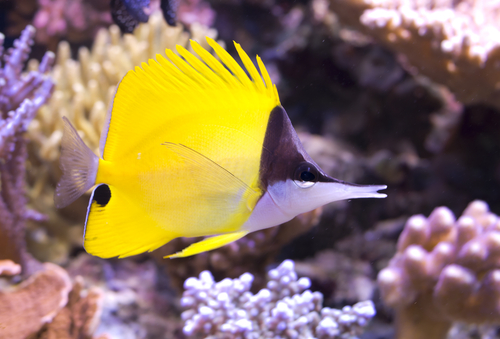
- Scientific Name: Forcipiger flavissimus
- Adult Size: 8 – 9 inches
- Compatible with: Large saltwater aquarium species
- Care Level: Easy to medium
- Origin: Widespread globally through tropical waters
Yellow longnose butterfly fish are attractive, even-tempered, mostly peaceful. They may compete for hiding places with snowflake eels
6. Emperor Angelfish
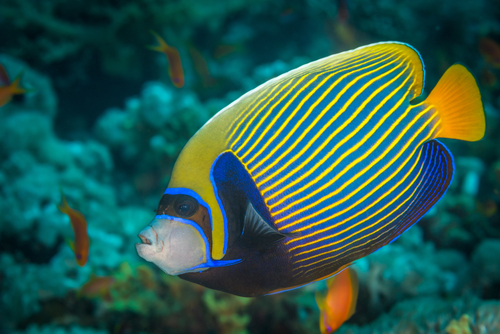
- Scientific Name: Pomacanthus imperator
- Adult Size: 12 inches
- Compatible with: Large saltwater fish of similar disposition and size
- Care Level: Medium to hard
- Origin: Indian and Pacific Oceans
Emperor angelfish are omnivorous, so feeding isn’t as difficult. They add beautiful color to your aquarium. Still, they are somewhat difficult to care for, and need a minimum tank size of 175 gallons. They may compete with snowflake eels for food and hiding places.
7. Foxface Rabbitfish
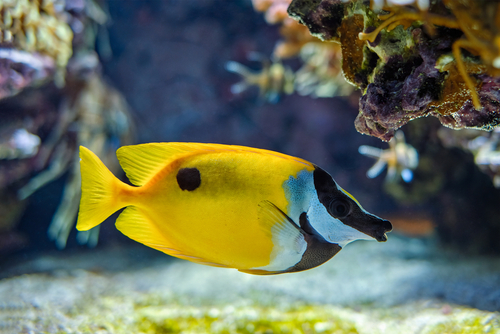
- Scientific Name: Siganus vulpinus
- Adult Size: 8 – 10 inches
- Compatible with: Large saltwater tank species
- Care Level: Medium
- Origin: Indo-Pacific coral reefs, especially in northern Australia and the Great Barrier Reef
Foxface rabbitfish are colorful, even-tempered and omnivorous.However, they are venomous and must be handled with care
8. Brittle Sea Star

- Scientific Name: Ophiura ophiura
- Adult Size: 12 – 24 inches
- Compatible with: Saltwater aquarium species that won’t mistake it for food
- Care Level: Easy to medium
- Origin: Indian and Pacific Oceans
Brittle sea star are the perfect snowflake eel tank mates because they keep the tank clean, they are attractive and peaceful. Still, they can grow quite large, may compete with snowflake eels for space at the bottom of the tank
9. Porcupine Pufferfish (aka Long-Spine Porcupinefish)
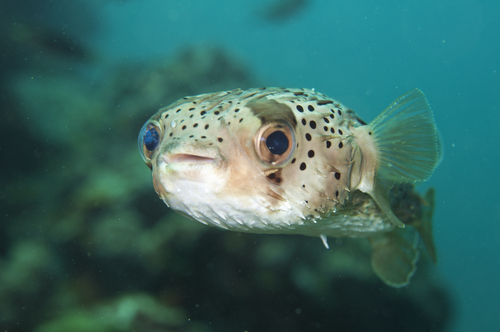
- Scientific Name: Diodon holocanthus
- Adult Size: 20 inches
- Compatible with: Large saltwater aquarium species
- Care Level: Hard
- Origin: Atlantic, Indian, and Pacific Oceans
Porcupine pufferfish have a fun personality and are attractive. They are somewhat difficult to care for, messy, easily stressed, require a minimum tank size of 200 gallons and may compete with snowflake eels for food.
10. Panther Grouper (aka Humpback Grouper)

- Scientific Name: Cromileptes altivelis
- Adult Size: 27 inches
- Compatible with: Large saltwater tank species
- Care Level: Moderate
- Origin: Western Pacific Ocean
Attractive, won’t compete for the same areas of tank with snowflake eels.They require a minimum tank size of 300 gallons and may compete with snowflake eels for food.
11. Reef Triggerfish

- Scientific Name: Rhinecanthus rectangulus
- Adult Size: 10 inches
- Compatible with: Large saltwater tank species
- Care Level: Easy
- Origin: Indo-Pacific Oceans
Reef triggerfish are easy to care for, and add color to your aquarium. Note that reef fish can be aggressive towards other triggerfish species.
12. Sand Sifting Starfish (aka Comb Sea Star)
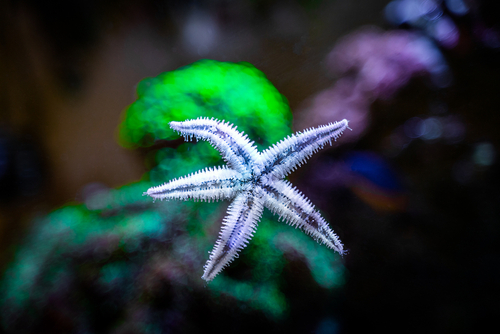
- Scientific Name: Astropecten polyacanthus
- Adult Size: 6 – 7 inches
- Compatible with: Saltwater aquarium fish and invertebrates
- Care Level: Easy
- Origin: Indo-Pacific Oceans
Sand sifting triggerfish are easy to care for, and helps keep the tank clean by filtering out toxins and debris.They are relatively small and may be mistaken for food by snowflake eels or other large tank mates.
13. Blue Tuxedo Urchin

- Scientific Name: Mespilia globulus
- Adult Size: 3 inches
- Compatible with: Most saltwater aquarium species that won’t mistake it for food
- Care Level: Easy
- Origin: Indian, Pacific, and Atlantic Oceans
The Blue tuxedo urchin are easy to care for, attractive and helps keep the tank clean by preventing buildup of algae. Although it may be mistaken as food by other tank mates, given its small size and immobility, they are the perfect tank companions for the snowflake eel.
14. Serpent Sea Star
- Scientific Name: Ophioderma cinereum
- Adult Size: 12 inches
- Compatible with: Any saltwater species that won’t mistake it for food
- Care Level: Easy to moderate
- Origin: Caribbean Sea
These fish arettractive, and help keep the tank clean by consuming detritus in sand or substrate.
Note that they may be mistaken for food by snowflake eel and other tank mates. Also, they may compete with snowflake eel for space at the bottom of the tank, especially in sand.
15. Leopard Wrasse

- Scientific Name: Macropharyngodon meleagris
- Adult Size: 6 inches
- Compatible with: Saltwater species that won’t mistake it for food
- Care Level: Very hard – expert only
- Origin: Fiji and South Pacific Ocean
Leopard wrasse have a beautiful pattern and are an attractive addition to saltwater tanks.
Still, these fish are notoriously difficult to care for, best suited for experts. Doesn’t fare well in captivity.
Summary
When choosing a tank mate for a snowflake eel, there are several factors you must keep in mind. Snowflakes eels like plenty of hiding places, so tank mates that don’t compete for limited space and occupy other areas of the aquarium (such as the middle or top layers of the water) are ideal.
Tank mates need to be aggressive enough to stand their ground against the snowflake eels and other tank mates, especially during feeding time. It’s usually not a concern to have tank mates that share the same diet of shellfish, crabs, and mollusks as the snowflake eel – but make sure there’s plenty of food to go around.
Any species that is small enough to fit into an eel’s mouth will eventually end up an unintended snack for your eel, given the snowflake eel’s bad eyesight. Never add more than one snowflake eel to the same tank, as snowflake eels are aggressive with one another and are known to be cannibalistic – especially when one is larger than the other.
It is vital to consider each species’ individual needs before adding them to the same tank. Your snowflake eel will be happy the more space it has and with plenty of hiding places.
FAQs
What species can share a tank with snowflake eels?
Answer: Large, aggressive saltwater species such as lionfish, wrasses, tangs, and triggerfish are great tank mates for snowflake eels. Invertebrates such as urchins and star fish are also safe, as they help keep the tank clean and aren’t part of the snowflake eel’s natural diet.
Can I keep crabs in the same tank as a snowflake eel?
Answer: No. Shellfish such as crabs, shrimp, mollusks, and lobsters are the snowflake eel’s natural prey and will quickly become food for your moray.
How small is too small a fish to share a tank with a snowflake eel?
You should think twice about adding any fish smaller than 5 inches to a tank with a snowflake eel.

Ian Sterling, founder of Fishlab.com, began his aquarium journey over 30 years ago, driven by a deep fascination for fish and their diverse personalities. His website, Fishlab.com, is dedicated to making fishkeeping accessible and enjoyable, offering beginner-friendly guidance, expert insights, and a community for aquarists to connect and share experiences.


